Input interpretation

tetrafluoromethane
Chemical names and formulas

formula | CF_4 name | tetrafluoromethane alternate names | arcton 0 | carbon tetrafluoride | FC-14 | Freon 14 | halocarbon 14 | halon 14 | R-14 | refrigerant 14 mass fractions | C (carbon) 13.6% | F (fluorine) 86.4%
Lewis structure
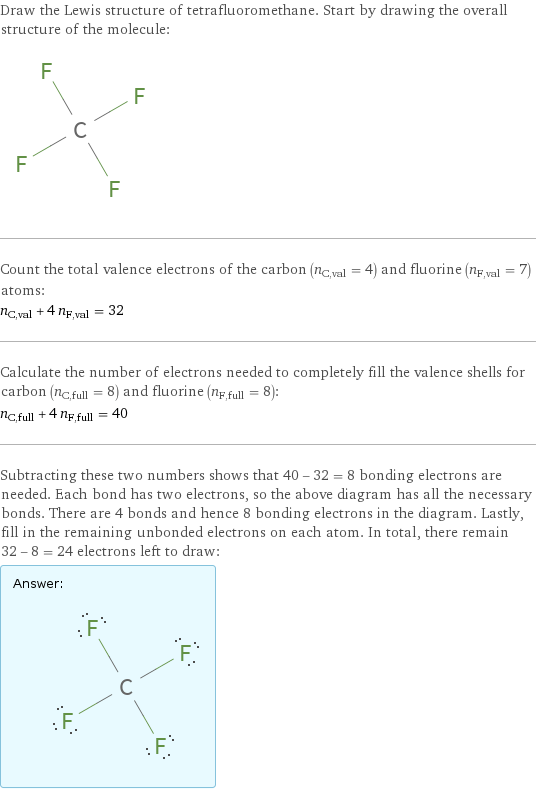
Draw the Lewis structure of tetrafluoromethane. Start by drawing the overall structure of the molecule: Count the total valence electrons of the carbon (n_C, val = 4) and fluorine (n_F, val = 7) atoms: n_C, val + 4 n_F, val = 32 Calculate the number of electrons needed to completely fill the valence shells for carbon (n_C, full = 8) and fluorine (n_F, full = 8): n_C, full + 4 n_F, full = 40 Subtracting these two numbers shows that 40 - 32 = 8 bonding electrons are needed. Each bond has two electrons, so the above diagram has all the necessary bonds. There are 4 bonds and hence 8 bonding electrons in the diagram. Lastly, fill in the remaining unbonded electrons on each atom. In total, there remain 32 - 8 = 24 electrons left to draw: Answer: | |
3D structure

3D structure
Basic properties
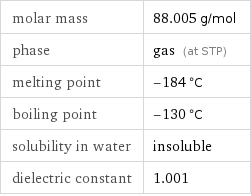
molar mass | 88.005 g/mol phase | gas (at STP) melting point | -184 °C boiling point | -130 °C solubility in water | insoluble dielectric constant | 1.001
Gas properties (at STP)

vapor density | 3.04 (relative to air) refractive index | 1.113 dynamic viscosity | 1.724×10^-5 Pa s (at 25 °C)
Units

Thermodynamic properties
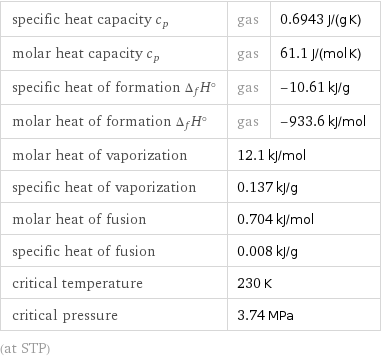
specific heat capacity c_p | gas | 0.6943 J/(g K) molar heat capacity c_p | gas | 61.1 J/(mol K) specific heat of formation Δ_fH° | gas | -10.61 kJ/g molar heat of formation Δ_fH° | gas | -933.6 kJ/mol molar heat of vaporization | 12.1 kJ/mol | specific heat of vaporization | 0.137 kJ/g | molar heat of fusion | 0.704 kJ/mol | specific heat of fusion | 0.008 kJ/g | critical temperature | 230 K | critical pressure | 3.74 MPa | (at STP)
Phase diagram
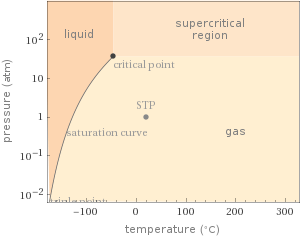
Phase diagram
Units

Chemical identifiers
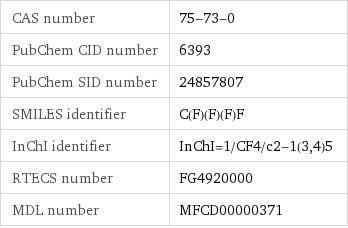
CAS number | 75-73-0 PubChem CID number | 6393 PubChem SID number | 24857807 SMILES identifier | C(F)(F)(F)F InChI identifier | InChI=1/CF4/c2-1(3, 4)5 RTECS number | FG4920000 MDL number | MFCD00000371
Safety properties

autoignition point | 1100 °C

DOT hazard class | 2.2 DOT numbers | 1982
Toxicity properties

RTECS classes | other